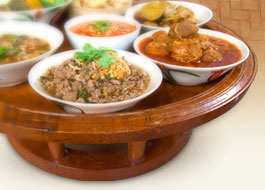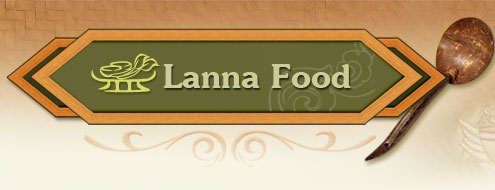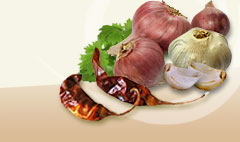Cherry tomato |
|
|
 | Lycopersicum esculentum |
|
| |
 | Solanaceae |
|
| |
 | Love apple, wild tomato, cherry tomato |
|
| |
 | Ma khuea som (Northern), nam moe (Lua-Chiang Mai), ma khuea (General), trop (Khmer-Surin), to trop (Khmer), huang kia (Chinese) (Kanchana Diwiset, et al., 1999, p. 191) |
|
| |
 | Annual Shrub, 1-2 m. high, softly hairy. Leaves pinnate, alternate; leaflets: one small and one large, ovate, thin, acuminate, uneven base, serrate, 5-7 cm. long. Inflorescence, axillary, 3-7 flowers, yellow, base cylindrical, 6-6 petals. Drupe varies but mostly ovate or flat and round; skin smooth, red-yellow, fleshy. Seeds numerous, indigenous variety has small round fruit like ma khuea phuang or berries come in cluster, slightly sour. Lanna people call it ba khuea ba-tae wnang, or ba khuea som puk. The red oval fruit and cherry like ones are called ba khuea som ba lot. (Rattana Phromphichai, 1999, p. 870) |
|
| |
 |

Ripe fruit eaten with yam, lap, sa, chili paste for kaeng khanun, kaeng sa lae and kaeng phak hueat. Ripe fruit can also be grilled and mixed in namphrik num, namphrik plara and namphrik ong. The tiny kind is preferable for namphrik ong. (Rattana Phromphichai, 1999, p. 870; Prathum Unsi, personal communication, July 25, 2007 ; Sirawit Chamrat, personal communication, June 15, 2007) |

Fruit are a mild laxative, thirst quencher and appetite booster. Rich in Vitamins A and C. Tomatine is anti-fungus, anti-bacteria. Roots and old leaves are boiled to relieve toothache. Leaves are pulverized and used as a sun screen for skin protection or used as a liquid to spray on plants to ward off vegetable worms (Rattana Phromphichai, 1999, p. 870). The red substance or lykopin protects against many kinds of cancer and problems with blood vessels around the heart. (Thaiwithong Hongwiwat, 2004, p. 59) |
|
| |
 | All year round |
|
| |
 |
Kanchana Diwiset, et al., comp. (1999). Phak Phuen Ban Phak Klang. Bangkok: Project on Text Development, Institute of Traditional Thai Medicine. (in thai). Tem Sithinand. (1980). Names of Thai Plants (Botanical Names Local Names) Bangkok: Royal Forestry Department. (in thai). Thaiwithong Hongwiwat. (1999). Saranukrom Phak. (2nd ed). Bangkok:Saengdaet. (in thai). Rattana Phromphichai. (1999). Khuea Som, Ba. inSaranukrom Wattanatham Thai Phak Nuea (Vol.2, p. 870). Bangkok: Siam Commercial Bank Foundation for the Encyclopedia of Thai Culture. (in thai). |
|
| |
|
|




